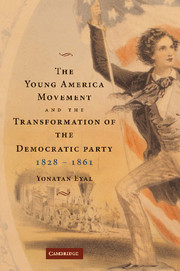Book contents
- Frontmatter
- Contents
- Acknowledgments
- Introduction: The Spirit of Young America
- 1 Orthodox Jacksonianism, 1828–1844
- 2 Trade and Improvements: The Economic Orientation of Young America Democrats
- 3 Rails, Canals, and a New Commercial Spirit
- 4 Young America Democrats and the Revolutions of 1848
- 5 A New International Consciousness
- 6 The Fires of Perfection Revisited
- 7 The Antislavery Democracy
- 8 New Democrats and the Coming of the Civil War
- Conclusion: Lincoln on Young America
- Index
8 - New Democrats and the Coming of the Civil War
Published online by Cambridge University Press: 31 July 2009
- Frontmatter
- Contents
- Acknowledgments
- Introduction: The Spirit of Young America
- 1 Orthodox Jacksonianism, 1828–1844
- 2 Trade and Improvements: The Economic Orientation of Young America Democrats
- 3 Rails, Canals, and a New Commercial Spirit
- 4 Young America Democrats and the Revolutions of 1848
- 5 A New International Consciousness
- 6 The Fires of Perfection Revisited
- 7 The Antislavery Democracy
- 8 New Democrats and the Coming of the Civil War
- Conclusion: Lincoln on Young America
- Index
Summary
Every student of the antebellum Democracy knows that the party split along sectional lines in 1860. Southern delegates walked out of the national convention following their northern colleagues' refusal to endorse a federal slave code for the western territories. By that point, the Democracy was ailing, fractured by old divisions between Van Burenites and Calhounites, antislavery Barnburners and secessionist fire-eaters. The handwriting of disunion was on the wall. In the middle, representing the once-unifying spirit of Young America, stood moderate Democrats such as Stephen Douglas, August Belmont, and Jesse Bright. They spoke for a conservative unionism that tried to keep the party and the country together without overreaching constitutional bounds. Stepping into this role was a natural move for the Young Americans, since their ideology had offered an amalgamating rallying cry for the party since the 1840s.
Instead of asking why the national Democracy collapsed in 1860, one might instead inquire how it managed to stay together for so long after the rise of sectional turmoil in 1846. This is the more illuminating question, given the sharp factional and sectional fissures that plagued the party during Young America's apex. New Democracy provides an answer to this question. The attitudes adopted by Young America Democrats kept their organization intact in times of crisis, softening differences by turning Democrats' eyes toward expansion, foreign intervention, and domestic economic growth. Without the rise of a Young America Democracy, the party (and perhaps the country) might have broken up sooner than 1860.
- Type
- Chapter
- Information
- The Young America Movement and the Transformation of the Democratic Party, 1828–1861 , pp. 202 - 228Publisher: Cambridge University PressPrint publication year: 2007



